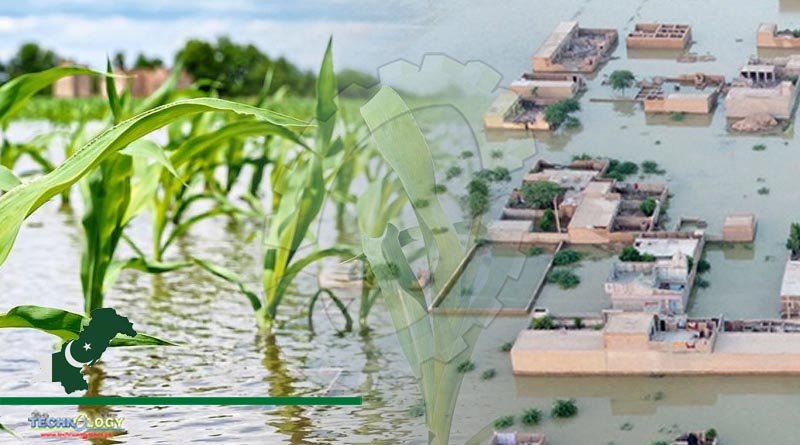As per the Post-Disaster Needs Assessment Report of the Govt of Pakistan, agriculture and livestock suffered significant damages of $3.7 billion and substantial losses of $9.2 billion.

The world has been falling behind in achieving SDGs of eradicating food insecurity, hunger and malnutrition. Support policies have failed to achieve their objectives which have caused unequal distribution and created market distortions. The situation in Pakistan is quite alarming, as the prevalence of undernourishment in the total population has reached 17%. The prevalence of food insecurity in Pakistan has reached 8.7% from 1% in 2014. In the last eight years, 17 million people have become food insecure.
Therefore, it can be assumed that the prevalence of food insecurity in 2022 could have been multiplied several times due to the devastating floods in Pakistan. As per the Post-Disaster Needs Assessment Report of the Government of Pakistan, agriculture and livestock suffered significant damages of $3.7 billion and substantial losses of $9.2 billion.
Floods have caused extensive destruction to 4.4 million acres of agricultural land and 0.8 million of livestock. The devastation of crops, livestock and aquaculture infrastructure and assets has resulted in temporary deterioration of livelihoods, employment and agriculture-related income, and has triggered food insecurity, malnutrition and hunger.
With the summer floods having severely damaged food crops on around 4.5m acres of land, the prices of vegetables and wheat in the country are touching record highs. Pakistan already ranks 99th out of 121 nations on the Global Hunger Index and has a level of hunger that is serious.
According to some estimates, around 15pc to 16pc Pakistanis are reeling from food insecurity and the situation continues to worsen after the devastating floods. Describing Pakistan’s food crisis as the worst in the country’s history, an official of the Food and Agriculture Organisation recently stated that the situation of the nation has deteriorated owing to the Covid-19 pandemic and recent floods.
Over the years, high food prices, lack of rainfall, drought and livestock diseases have all added to the food insecurity being witnessed now. The flood damage to crops is making matters worse as the country already has some of the highest levels of malnutrition in the world, which is increasing due to the high prices of basic food items; all this is especially affecting women and children.
Food insecurity is unlikely to lessen in the next several months as shortages will keep prices elevated. Rather, the crisis may deepen further in the near term if wheat sowing is delayed and output drops due to water-logging in the areas hit by the floods. Although the government has decided to purchase 450,000 tonnes of cereal from Russia on a government-to-government basis ahead of the next wheat harvest, the soaring prices will keep the staple food out of reach for the vast majority in the country.
With the people facing hardship in an inflationary environment, it is imperative for the government to ensure that it bridges food supply gaps and takes measures to keep prices at an affordable level for the average Pakistani, especially those from flood-affected areas.
Agriculture contributes 19.2% to the GDP and employs 38.5% of the labour force. The agriculture sector output multiplier is estimated to be around 1.43. This represents the sector’s ability to multiply input of 1% into output by 1.43%. The share of private consumption expenditure for the agriculture sector is 12%, the fourth highest by any sector in private consumption expenditure.
Thus, the agriculture sector has an important role to play in eradicating food insecurity, undernourishment and hunger. However, arable land per capita has decreased over the years due to agricultural land use for non-farming purposes. Productivity has declined due to obsolete practices, excessive use of pesticides, unavailability of quality seeds, and unfriendly policies on new technology.
Pakistan has the potential to adopt modern tools to enhance its agricultural output and eradicate food insecurity and malnutrition. A 1% increase in tech-based investments in agriculture can enhance sectorial output by 3% and GDP by 0.68%. Improved productivity would result in a higher food supply which may lead to a decline in domestic prices by 3%, but real wages would improve by 0.8% for unskilled labour and 1% for skilled labour. Therefore, it can be deduced with conviction that technology-driven growth in agriculture would lift millions out of poverty, improve food security and bring sustainability to society.
The report published by Food and Agriculture Organization (FAO) on Food Security 2022 highlighted undernourishment in the global population which increased from 8% in 2019 to 9.3% in 2020 and 9.8% in 2021. Globally, 700 to 800 million people have faced hunger in 2021.
The report also stated that 20.2% of the population faced hunger in Africa compared to 9.1% in Asia, 8.6% in Latin America, 5.8% in Oceania and 2.5% in North America. Shocks like Covid-19 and the Ukraine war have further exacerbated the risk of food insecurity and malnutrition. The World Bank in its climate explainer series indicated that 345 million people may have suffered acute food insecurity in 2022 due to supply chain disruptions.
Originally published at The Express Tribune
